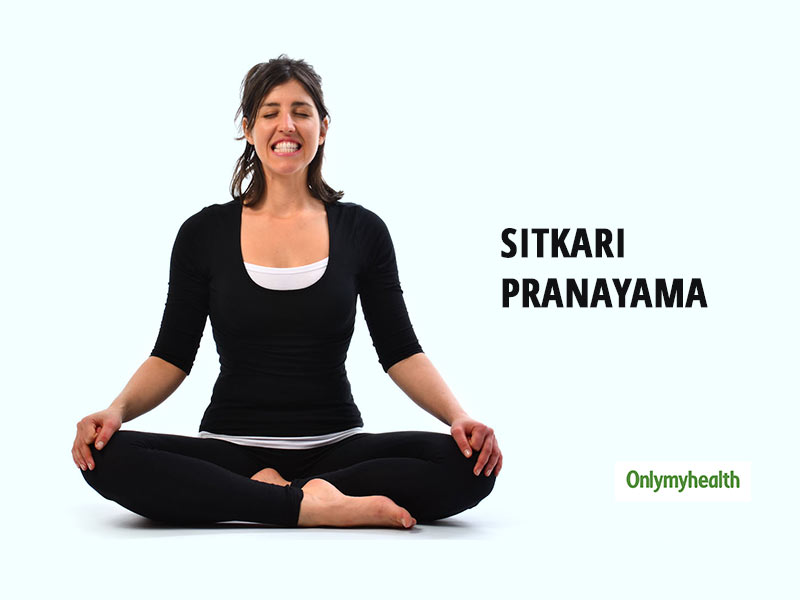
International Yoga Day 2020: What is Sitkari Pranayama? Sitkari means 'coolness' means to cool our body and mind, while doing this pranayama; the sound of the word 'Sit' has to be emitted from the mouth. And for this reason, this pranayama was named Sitkari Pranayama. This pranayama is also very simple and useful and should be done in the summer season only. Let us know its benefits and how to do this pranayama.
Table of Content:-
Method of performing sitkari pranayama
- First of all, spread the yoga mat on clean and flat ground and sit on it in the posture of Siddhasana.
- Now keep your spine and head straight.
- Place your lower jaw teeth on the top jaw teeth.
- Now put your tongue behind your teeth and keep your mouth slightly open so that you can breathe.
- Bend your tongue backwards and apply the front part of the tongue from the palate.
- Now inhale slowly from the place of your teeth.
- Repeat this process 10-15 times.
- If you practice it every day, then you will get good results. Practising this pranayama on an empty stomach in the morning and the evening is more fruitful. Try to do this process ten to fifteen times according to your ability.
Also Read: Challenge Your Body To Increase Strength and Stamina with Rope Wall Yoga
Benefits of Sitkari Pranayama
- Brings agility to the body: By doing Sitkari Pranayama, the body gets tired, and the body gets agitated. According to psychologists, fatigue is a state of loss of interest and desire. The general meaning of physical exhaustion is derived from the decrease in strength of mind or body. The body remains elated throughout the day from Sitkari Pranayama's morning practice.
- Anorexia: Loss of appetite in medical language is called anorexia. In anorexia, the patient does not feel hungry, even if forced to eat, he/she feels distasteful. A person suffering from this disease is unable to eat more than 1 or 2 grains, and he/she starts having sour buds without eating anything.
- Keep the body temperature balanced: By its regular practice, the body temperature remains stable. When the body temperature exceeds normal, that condition is called fever. It is not a disease but a symptom which shows that the system of controlling the temperature of the body has increased the desired temperature (set-point) of the body by 1-2 degrees.
- Get rid of stomach irritation: The practice of this pranayama eliminates the problem of stomach irritation. It is essential to digest the food we eat properly. In the process of digestion, our stomach secretes an acid which is very important for metabolism.
- Sleeplessness: It is necessary to get a good sleep because it removes fatigue and fills the body with energy and strength. If you have sleep-related problems, then you can get rid of them by practising this pranayama.
- Sweat: Sweating is a natural function of our body, which keeps the body temperature under control. Sweat separates on the skin and emits steam, which causes the body to cool down. It only happens when the body temperature exceeds a threshold.
- Cleaning the internal organs: This pranayama also cleanses the internal organs of the body. The eyes do not see the inner filth; the symptoms only know it. Therefore, many people do not pay attention to that.
- Glow on the face: By practising this pranayama, you can bring natural glow on our face because it cleanses the blood that enhances the natural shine on the face.
- Keeps the amount of oxygen intact: Regular practice of Sitkari Pranayama does not reduce the amount of oxygen in the body.
- Suitable for the blood circulation process: Regular practice improves blood circulation process in the body.
- Enhances physical aura: Regular morning and evening practice of this pranayama can improve physical aura.
Also Read: Yoga For Flexibility, 5 Poses That Non-Flexible People Should Perform
Caution in performing Sitkari Pranayama
- This pranayama should always be done on an empty stomach.
- This pranayama should not be done by asthma, phlegm and tonsils patients and in cold and cough diseases.
- It should not be practised in the winter season. Practice this in a clean area, avoid dusty areas.
Read more in Yoga
Read Next
International Yoga Day Quiz: Method, Benefits And Precautions While Doing Halasana (Plough Pose)
How we keep this article up to date:
We work with experts and keep a close eye on the latest in health and wellness. Whenever there is a new research or helpful information, we update our articles with accurate and useful advice.
Current Version
